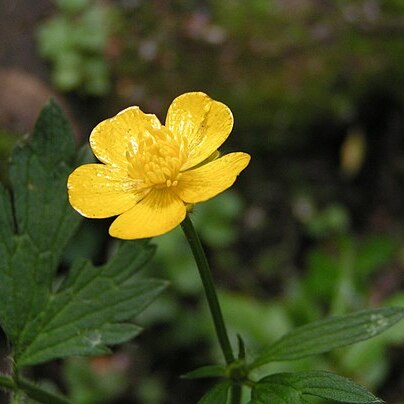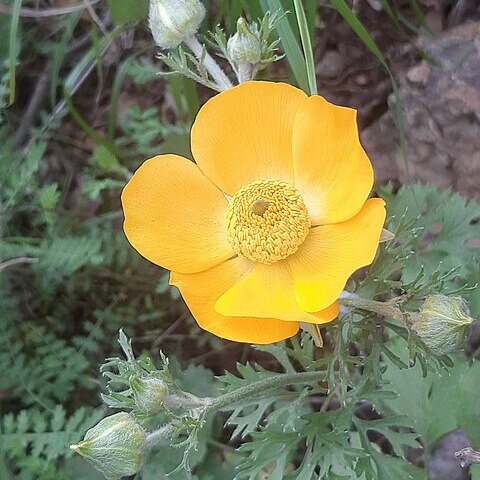Herbs , annual or perennial, from tuberous roots, caudices, rhizomes, stolons, or bulbous stem bases. Leaves basal, cauline, or both, simple, variously lobed or parted, or compound, all petiolate or distal leaves sessile; cauline leaves alternate (rarely a distal pair opposite in Ranunculus sect. Flammula ). Leaf blade reniform to linear, margins entire, crenate, or toothed. Inflorescences terminal or axillary, 2-50-flowered cymes to 25 cm or solitary flowers; bracts present or absent, small or large and leaflike, not forming involucre. Flowers bisexual, radially symmetric; sepals sometimes persistent in fruit, 3-5(-6), green or sometimes purple, yellow, or white, plane (base saccate in R . ficaria ), oblong to elliptic, ovate, or lanceolate, 1-15 mm; petals 0-22(-150), distinct, yellow, rarely white, red, or green, plane, linear to orbiculate, 1-26 mm; nectary present, usually covered by scale; stamens (5-)10-many; filaments filiform; staminodes absent between stamens and pistils; pistils 4-250, simple; ovule 1 per ovary; style present or absent. Fruits achenes, rarely utricles, aggregate, sessile, discoid, lenticular, globose, obovoid, or cylindric, sides sometimes veined; beak present or absent, terminal, straight or curved, 0-4.5 mm. x = 7, 8.
Annual or perennial herbs, some aquatics. Roots fibrous to fleshy-tuberiform. Stems erect, creeping or stoloniferous. Leaves spiral, cauline, alternate and/or in a basal rosette, without stipules; petioles with gradually tapering leaf sheath; blades simple, entire, or more often palmately lobed or pinnately dissected, or compound, trifoliolate or imparipinnate; repeatedly trichotomously or dichotomously divided into filiform segments in Ranunculus trachophyllus. Flowers solitary and terminal, or sometimes in cymes, bisexual, actinomorphic, all parts spiral. Sepals usually 5, rarely fewer, sometimes reflexed. Petals 5–15, rarely fewer, yellow or white or white with a yellow claw, often glossy, sometimes matt above, lacking spurs, but each with a nectar-secreting pit on the adaxial surface mostly in the lower half and often covered by a sometimes laterally adnate lobe which then forms a nectary-pocket. Stamens numerous, rarely only 5 or fewer. Carpels free, usually numerous, with 1 basal ovule. Fruit a head of smooth or ridged achenes each with a usually persistent (sometimes caducous or vestigial), glabrous style-beak.
Glabrous to pubescent erect or procumbent herbaceous annuals or perennials, the stems occasionally rooting at the nodes, the roots fibrous, fascicled. Leaves radical or cauline, exstipulate, entire, dissected or compound, alternate or rarely opposite, glabrous to pubescent, often with acrid juice. Inflorescence terminal, the flowers perfect; sepals 5(-3-6), imbricate, caducous; petals (O-)5(-26), yellow, white or red, separate, with a nectariferous pit at the base, unguiculate; stamens commonly 10, often more, rarely fewer; anthers 2-celled, basifixed, longitudinally dehiscent; carpels 5-many, the single ovule attached near the base of the cell. Achenes capped by the elongate style, glabrous or hairy, smooth or variously ornate.
Perennial, sometimes annual, terrestrial or aquatic herbs; roots fibrous or swollen, sometimes arising from a stout or bulbous rootstock. Lvs usually alternate, rarely opposite, basal and cauline, simple or variously divided to 2-pinnatisect. Fls solitary or in lax leafy cymes; involucre 0. Sepals green, (3)-5-(7). Petals (0)-5-(12 or more), usually yellow, sometimes white, brown or reddish; nectaries near base of petal, 1-(3), pit-like, covered by a scale or naked. Stamens few to many, spiralled. Carpels few to many, with 1 ovule. Achenes few to many; style neither greatly elongated nor feathery. Receptacle glabrous or hairy, globular or cylindric.
Fls solitary to paniculately arrayed, perfect, regular, hypog. Sepals 3-5, deciduous or caducous; petals (0)-5-25 or more, yellow or white, with 1 or more nectary glands; stamens us. ∞; carpels in heads, us. ∞, with basal ovule; fr. of achenes. Annual to perennial herbs; lvs us. exstipulate, mostly radical, often variously lobed or dissected. Over 300 spp., chiefly of temperate regions. Of the N.Z. spp. forms of R. hirtus, R. lappaceus and R. rivularis occur in Australia and Tasmania; of R. acaulis in Tasmania and Chile. R. biternatus has a wide range in austral regions.
Fls regular; sep green or yellowish, 3, 4, or more commonly 5, rarely more; pet mostly 5, sometimes fewer or more, each with a nectariferous pit or scale on the upper side at the base; stamens mostly numerous, rarely as few as 5; pistils numerous in a globose, ovoid, or cylindric head; ovule ordinarily 1, erect or ascending; fr an achene; annual or perennial herbs with alternate, entire to much dissected lvs and yellow, white, or rarely red fls; juice acrid, poisonous. (Batrachium, Ceratocephalus, Ficaria) 250+, ± cosmop.
Herbs with simple or compound spirally arranged leaves, usually ex-stipulate. Flowers regular, in one-to many-flowered inflorescences, without definite involucres of bracts or reduced leaves. Sepals spreading or reflexed in anthesis. Petals 5–8 or more, white, yellow, or with anthocyanin colours, with basal nectariferous pit with or without a scale. Stamens indefinite in number. Carpels indefinite in number, uniovulate. Achenes with persistent, glabrous, sometimes hooked style.
Perennial herbs with simple or compound petiolate radical leaves and spirally arranged cauline leaves with sheathing bases.
Petals 5–8 or more, usually yellow or white with a basal nectariferous pit with or without a scale.
Flowers actinomorphic in 1-many-flowered inflorescences.
Fruit of numerous achenes with usually glabrous styles.
Sepals spreading or reflexed in anthesis.
Carpels indefinite in number, 1-ovulate.
Stamens indefinite in number.


